SBOK061 October 2022 SN54SLC8T245-SEP
5.1 Single Event Latchup (SEL) Results
During SEL characterization, the device was heated using forced hot air, maintaining the IC temperature at 125°C. The temperature was monitored by means of a K-type thermocouple attached as close to the IC as possible. The species used for the SEL testing was a silver (47Ag) ion with an angle-of-incidence of 0° for an LETEFF = 43 MeV-cm2/mg. The kinetic energy in the vacuum for this ion is 1.634 GeV (15-MeV/amu line). A fluence of approximately 2 x 107 ions were used for the run. The VCCA and VCCB supply voltage is supplied externally onboard at the recommended maximum voltage setting of 3.6 V. Run duration to achieve this fluence was approximately 3 minutes. As provided in Table 5-1, no SEL events were observed during run time. Figure 5-1 shows a plot of the current versus time.
| RUN # | DISTANCE (mm) | TEMPERATURE (°C) | ION | ANGLE | FLUX (ions·cm2/mg) | FLUENCE (# ions) | LETEFF (MeV.cm2/mg) |
|---|---|---|---|---|---|---|---|
1 | 40 | 125 | Ag | 0° | 1.00E+05 | 2.00E+07 | 43 |
No SEL events were observed, indicating that the SN54SLC8T245-SEP is SEL-immune at LETEFF = 43 MeV-cm2/mg and T = 125°C. Using the MFTF method described in Single-Event Effects (SEE) Confidence Interval Calculations application report, the upper-bound cross section (using a 95% confidence level) is calculated as:
 Figure 5-1 Current vs Time (I vs t) Data for Vs Current During SEL Run # 1
Figure 5-1 Current vs Time (I vs t) Data for Vs Current During SEL Run # 1